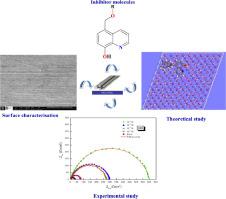当前位置:
X-MOL 学术
›
Surf. Interfaces
›
论文详情
Our official English website, www.x-mol.net, welcomes your
feedback! (Note: you will need to create a separate account there.)
Chemically functionalized of 8-hydroxyquinoline derivatives as efficient corrosion inhibition for Steel in 1.0 M HCl solution: Experimental and Theoretical studies
Surfaces and Interfaces ( IF 5.7 ) Pub Date : 2020-12-01 , DOI: 10.1016/j.surfin.2020.100695 M. Galai , M. Rbaa , M. Ouakki , Ashraf S. Abousalem , E. Ech-chihbi , K. Dahmani , N. Dkhireche , B. Lakhrissi , M. EbnTouhami
Surfaces and Interfaces ( IF 5.7 ) Pub Date : 2020-12-01 , DOI: 10.1016/j.surfin.2020.100695 M. Galai , M. Rbaa , M. Ouakki , Ashraf S. Abousalem , E. Ech-chihbi , K. Dahmani , N. Dkhireche , B. Lakhrissi , M. EbnTouhami

|
Abstract The challenge of this work is the functionalization of new 8-hydroxyquinoline derivatives by a simple method achieving a very good yield (80–90%).The corrosion inhibition performance of two neworganic compounds derived from quinolin-8-ol, namely, BMQ and DEMQ for mild steel in 1.0 M HCl solution was studied usingPotentiodynamic polarization (PDP)and electrochemical impedance spectroscopy (EIS).Scanning electron microscopy (SEM) coupled with the energy dispersive spectroscopy (EDX) were used to characterize and analyze the surface of steel.The theoretical study wasalso carried out by DFT calculations (structure-reactivity) and Monte Carlo, MC (inhibitor-surface) simulations. The electrochemical results showed that both studied molecules provide high resistance and that the inhibition efficiency (η%) reaches 94% at 10−3 M for BMQ. PDP measurements revealed that these compounds function as mixed type corrosion inhibitors. In addition, they can be adsorbed on the steel surface by chemical bonds following Langmuir adsorption isotherm. Also, both inhibitors remain effective at high temperatures (86% at 328 K for the concentration 10−3 M).DFT calculations show that the free heteroatom doublets of oxygen (O), nitrogen (N) and the methyl groups (–CH3) favor the sharing of electrons between the studiedmolecules and the surface of the steel. The data of theoretical methods (DFT and MC) supported the experimental findings.
中文翻译:

8-羟基喹啉衍生物的化学功能化可有效抑制钢在 1.0 M HCl 溶液中的腐蚀:实验和理论研究
摘要 这项工作的挑战是通过简单的方法对新型 8-羟基喹啉衍生物进行功能化,获得非常好的产率(80-90%)。来自喹啉-8-醇的两种新型有机化合物,即 BMQ 的缓蚀性能使用动电位极化 (PDP) 和电化学阻抗谱 (EIS) 研究了低碳钢在 1.0 M HCl 溶液中的 DEMQ 和 DEMQ。 扫描电子显微镜 (SEM) 结合能量色散谱 (EDX) 对钢的表面进行表征和分析. 还通过 DFT 计算(结构-反应性)和 Monte Carlo, MC(抑制剂-表面)模拟进行了理论研究。电化学结果表明,两种研究的分子都提供高电阻,并且 BMQ 在 10-3 M 时的抑制效率 (η%) 达到 94%。PDP 测量表明这些化合物起到混合型腐蚀抑制剂的作用。此外,它们可以通过朗缪尔吸附等温线的化学键吸附在钢表面。此外,两种抑制剂在高温下仍然有效(328 K 时,浓度为 10-3 M 时为 86%)。 DFT 计算表明氧 (O)、氮 (N) 和甲基 (–CH3) 的游离杂原子双峰有利于研究分子和钢表面之间的电子共享。理论方法(DFT 和 MC)的数据支持了实验结果。两种抑制剂在高温下仍然有效(328 K 时,浓度为 10-3 M 时为 86%)。 DFT 计算表明氧 (O)、氮 (N) 和甲基 (–CH3) 的游离杂原子双峰有利于研究分子和钢表面之间的电子共享。理论方法(DFT 和 MC)的数据支持了实验结果。两种抑制剂在高温下仍然有效(328 K 时,浓度为 10-3 M 时为 86%)。 DFT 计算表明氧 (O)、氮 (N) 和甲基 (–CH3) 的游离杂原子双峰有利于研究分子和钢表面之间的电子共享。理论方法(DFT 和 MC)的数据支持了实验结果。
更新日期:2020-12-01
中文翻译:

8-羟基喹啉衍生物的化学功能化可有效抑制钢在 1.0 M HCl 溶液中的腐蚀:实验和理论研究
摘要 这项工作的挑战是通过简单的方法对新型 8-羟基喹啉衍生物进行功能化,获得非常好的产率(80-90%)。来自喹啉-8-醇的两种新型有机化合物,即 BMQ 的缓蚀性能使用动电位极化 (PDP) 和电化学阻抗谱 (EIS) 研究了低碳钢在 1.0 M HCl 溶液中的 DEMQ 和 DEMQ。 扫描电子显微镜 (SEM) 结合能量色散谱 (EDX) 对钢的表面进行表征和分析. 还通过 DFT 计算(结构-反应性)和 Monte Carlo, MC(抑制剂-表面)模拟进行了理论研究。电化学结果表明,两种研究的分子都提供高电阻,并且 BMQ 在 10-3 M 时的抑制效率 (η%) 达到 94%。PDP 测量表明这些化合物起到混合型腐蚀抑制剂的作用。此外,它们可以通过朗缪尔吸附等温线的化学键吸附在钢表面。此外,两种抑制剂在高温下仍然有效(328 K 时,浓度为 10-3 M 时为 86%)。 DFT 计算表明氧 (O)、氮 (N) 和甲基 (–CH3) 的游离杂原子双峰有利于研究分子和钢表面之间的电子共享。理论方法(DFT 和 MC)的数据支持了实验结果。两种抑制剂在高温下仍然有效(328 K 时,浓度为 10-3 M 时为 86%)。 DFT 计算表明氧 (O)、氮 (N) 和甲基 (–CH3) 的游离杂原子双峰有利于研究分子和钢表面之间的电子共享。理论方法(DFT 和 MC)的数据支持了实验结果。两种抑制剂在高温下仍然有效(328 K 时,浓度为 10-3 M 时为 86%)。 DFT 计算表明氧 (O)、氮 (N) 和甲基 (–CH3) 的游离杂原子双峰有利于研究分子和钢表面之间的电子共享。理论方法(DFT 和 MC)的数据支持了实验结果。











































 京公网安备 11010802027423号
京公网安备 11010802027423号